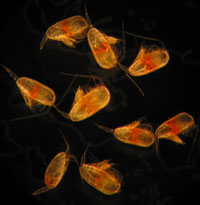Using phytoplankton to trap carbon dioxide faces a snag
Messing around with ecosystems is an unpredictable business. That proved true again this week when a group of Indian and German researchers gave their first report from the biggest ever experiment in geo-engineering: an expedition to pour iron into the Southern Ocean, a vast area that encircles Antarctica, to stimulate a giant bloom of phytoplankton.

We did!
Phytoplankton are tiny algae that absorb carbon dioxide when they grow and then lock up some of the greenhouse gas when they die and sink to the seabed. Stimulate the growth of more phytoplankton, the theory goes, and you might send more CO2 to the bottom of the ocean, where it cannot contribute to global warming. But the experiment did not quite turn out like that.
The voyage, a joint venture by India’s National Institute of Oceanography and the Alfred Wegener Institute for Polar and Marine Research in Germany, was controversial from the start. Some environmental groups claimed it was akin to pollution, and thus illegal. At one point, therefore, the German government ordered the Wegener Institute to suspend operations while it looked into the matter. Eventually, permission to continue was given and the research ship Polarstern made a two-and-half-month passage through stormy seas following the bloom that the researchers had created.
The growth of phytoplankton is kept in check by the amount of sunlight available for photosynthesis and the supply of crucial nutrients such as iron. In the Southern Ocean, iron is indeed often the limiting nutrient. As a result, when iron levels increase naturally (for example when a dust storm dumps large amounts of it into the sea) giant blooms of phytoplankton can suddenly appear. Previous studies have shown that adding iron artificially can also create algal blooms. The expedition’s researchers wanted to find out how many of the extra algae end up on the sea bed.
Those researchers, led by Wajih Naqvi and Victor Smetacek, created a bloom of phytoplankton by fertilising an area of 300 square kilometres with six tonnes of iron sulphate, which dissolves in water. In two weeks the bloom’s mass doubled. But it also proved to be extremely tasty for small crustaceans called copepods, which gobbled the phytoplankton up so quickly that even with further iron fertilisation the bloom stopped growing. As a result, only a small amount of CO2 was dispatched to the ocean floor.
The problem lay with the species of phytoplankton in the bloom. In previous experiments the blooms had consisted of a group of algae known as diatoms. As diatoms have shells made of silica they are protected from copepods and so are more likely to die without being eaten and thus take take their carbon to the ocean floor. But in the area where the researchers were working natural blooms had already depleted much of the silicic acid, which the diatoms use for shellmaking. The result was that the beneficiaries of the iron were instead groups of algae such as Phaeocystis, which are among the most heavily grazed by copepods.
Since silicic-acid levels are naturally low across about two-thirds of the Southern Ocean, the expedition’s results suggest that iron-fertilisation would remove less CO2 from the atmosphere than optimists had hoped. Although that is a setback for proponents of large-scale iron-fertilisation, the results from the Polarstern expedition have given researchers lots to work on, including the role predators play in reducing algal blooms. And the results in one part of the ocean may be different from those in another because, as Ulrich Bathmann of the Wegener Institute points out, ecosystems in the sea are at least as diverse as those on the land. So the team may make another voyage to discover more.
Source: The Economist
Short link: http://whatel.se/~lkM$2b

Recent Comments